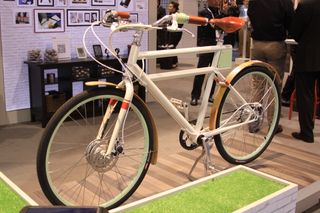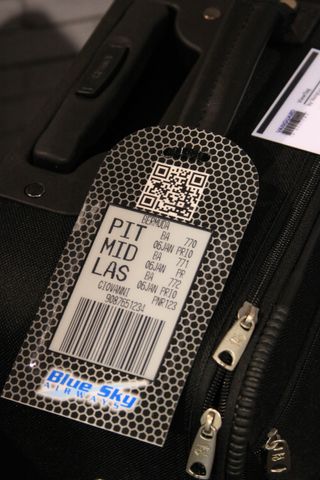E-Ink: No More Lost Luggage?
E-Ink isn't just for your e-reader.

You know E-Ink, the company behind the paper-like reading experience of e-readers like the Kindle Paperwhite. E-Ink is rapidly moving its technology into a variety of other market segments, where its technology's longevity, low power consumption and cost effectiveness seem to be a perfect fit, from watches to wall clocks, from thermostats to digital signage, from bikes to luggage tags.

E-Ink was showcasing many of these innovations at the Consumer Electronics Show in Las Vegas this week, including announcements with Twelve24 and Faraday Bicycles. Twelve24 announced ClockONE, a wall clock that's about 1 meter long, 4 mm thick, and weighs less than 4 pounds, but uses E-Ink instead of LEDs (it also has a nifty one-screw, magnetic wall-hanging mechanism). Faraday Bicycles announced its Porteur, an electronic-assist bike that uses E-Ink to show the bike's battery status.

One of the most compelling applications was a new luggage tag, in a trial that Vanguard ID is running with a major airline. These tags have RFID, so the airline can transmit its information. That information is displayed and kept on the tag using -- you guessed it -- E-Ink. Just send your itinerary from your phone to the luggage tag via Bluetooth, and there it is. No more lost baggage. (Insert cynicism here.)
E-Ink also demonstrated a virtual printer from Sony. This was launched in mid-2013, but it's still an interesting concept for organizations that manage lots of documents. In a sense, you "print" a document to the Sony device -- it looks like a paper-sized (8-1/2 x 11), super-thin Kindle. You can highlight and annotate the output.

And there were watches (the confusing rorschach watch from Tokyo Flash Japan), the Lennox Thermostat, conference room agenda signs, USB drives (telling you how much space you've used) and even shelf tags for grocery stores (especially helpful in refrigerated sections, which do not impair the E-Ink devices).
Stay on the Cutting Edge
Join the experts who read Tom's Hardware for the inside track on enthusiast PC tech news — and have for over 25 years. We'll send breaking news and in-depth reviews of CPUs, GPUs, AI, maker hardware and more straight to your inbox.
Last year at CES Yotaphone got some attention -- it's an Android phone with an LCD screen on one side and E-Ink on the other -- for images and calendars and things that you may want to keep on the screen a little longer, like a map. The E-Ink side requires less power, so you can shut off the LCD screen and still have something useful on the E-Ink screen. Yotaphone is now in mass production, and sells for about $650.
The E-Ink technology works by moving white and black pigments with an electrical charge. Those pigments are coated in a thin film, which gives them flexibility. E-Ink now also includes a red pigment, which is given a different property. A company spokesman said the company isn't ready to reveal how it does this.
Check out all of our CES 2014 coverage!
-
smeezekitty I think e-ink technology is quite meet. A lot less eye strain compared to LCD for example.Its biggest problem is update rate. Full gray scale screen refreshes take several hundred milliseconds.By using only black and white pixels and dither it is possible to reach much higher refresh rates at the expense of image quality.Reply -
acadia11 I want to kill myself I thought about the luggage thing just this weekend!!!! But was thinking of doing it as wearable oled tech.Reply -
smeezekitty Reply12399367 said:I just wish there were more E-ink open-source tablets available.
Big +1
Most Popular



